Volkswagen's External Environment: Opportunities, Threats & Analysis
VerifiedAdded on 2023/06/13
|16
|3570
|53
Report
AI Summary
This report analyzes Volkswagen's external environment across eight major domains: technological, economic, labor, resource, legal/regulatory, and global environments. It highlights the impact of these domains on VW's strategic position, particularly in light of recent technological and economic challenges like the "VW Scandal." The analysis identifies key opportunities such as technological advancements for environmentally friendly production and competitive strategies including market awareness and resource optimization through brand diversification. Threats include intense competition, economic instability, and stringent regulatory requirements. The report concludes with a summary of the main external issues facing VW, emphasizing their implications for the company's survival, competitive advantage, and growth prospects, and aims to provide valuable insights for senior management.
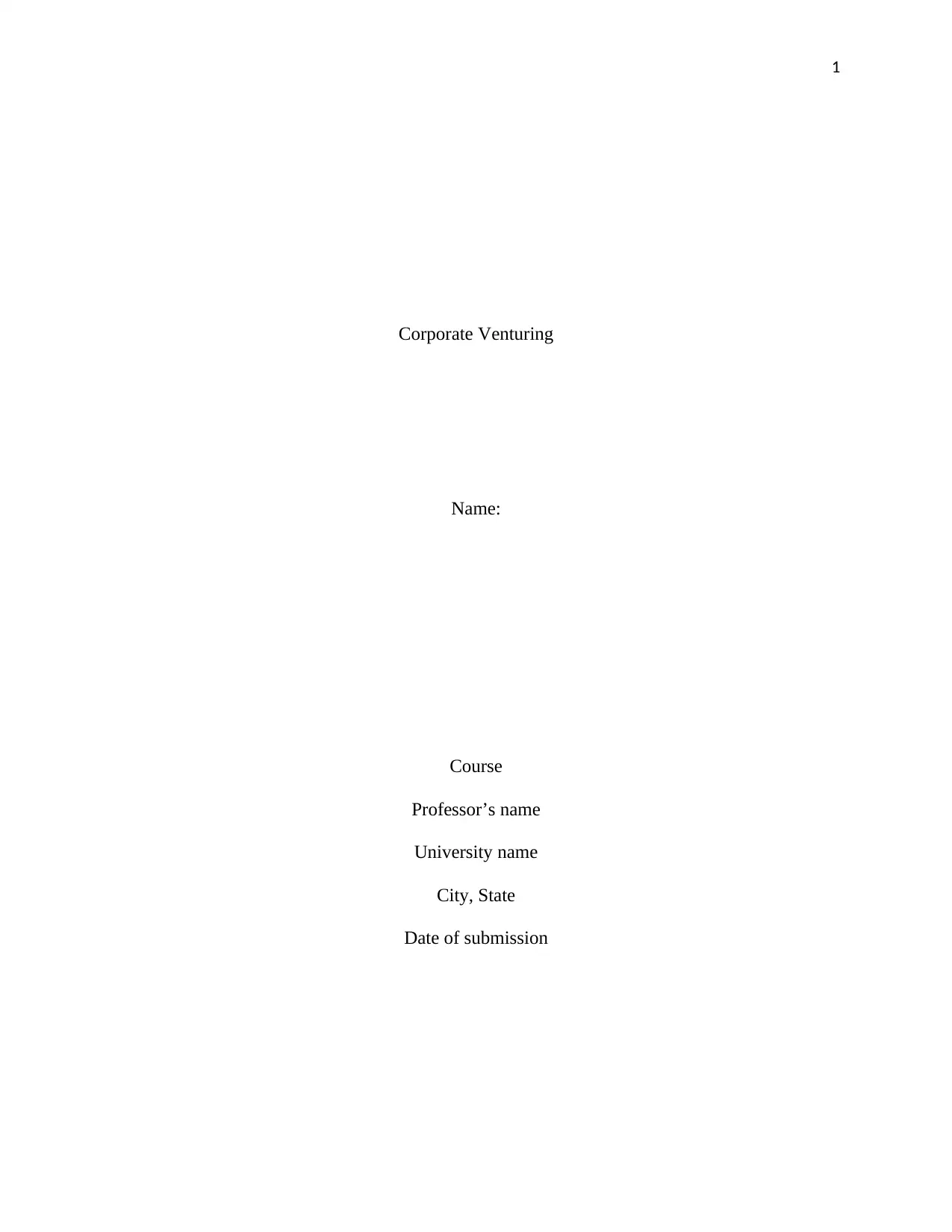
1
Corporate Venturing
Name:
Course
Professor’s name
University name
City, State
Date of submission
Corporate Venturing
Name:
Course
Professor’s name
University name
City, State
Date of submission
Paraphrase This Document
Need a fresh take? Get an instant paraphrase of this document with our AI Paraphraser
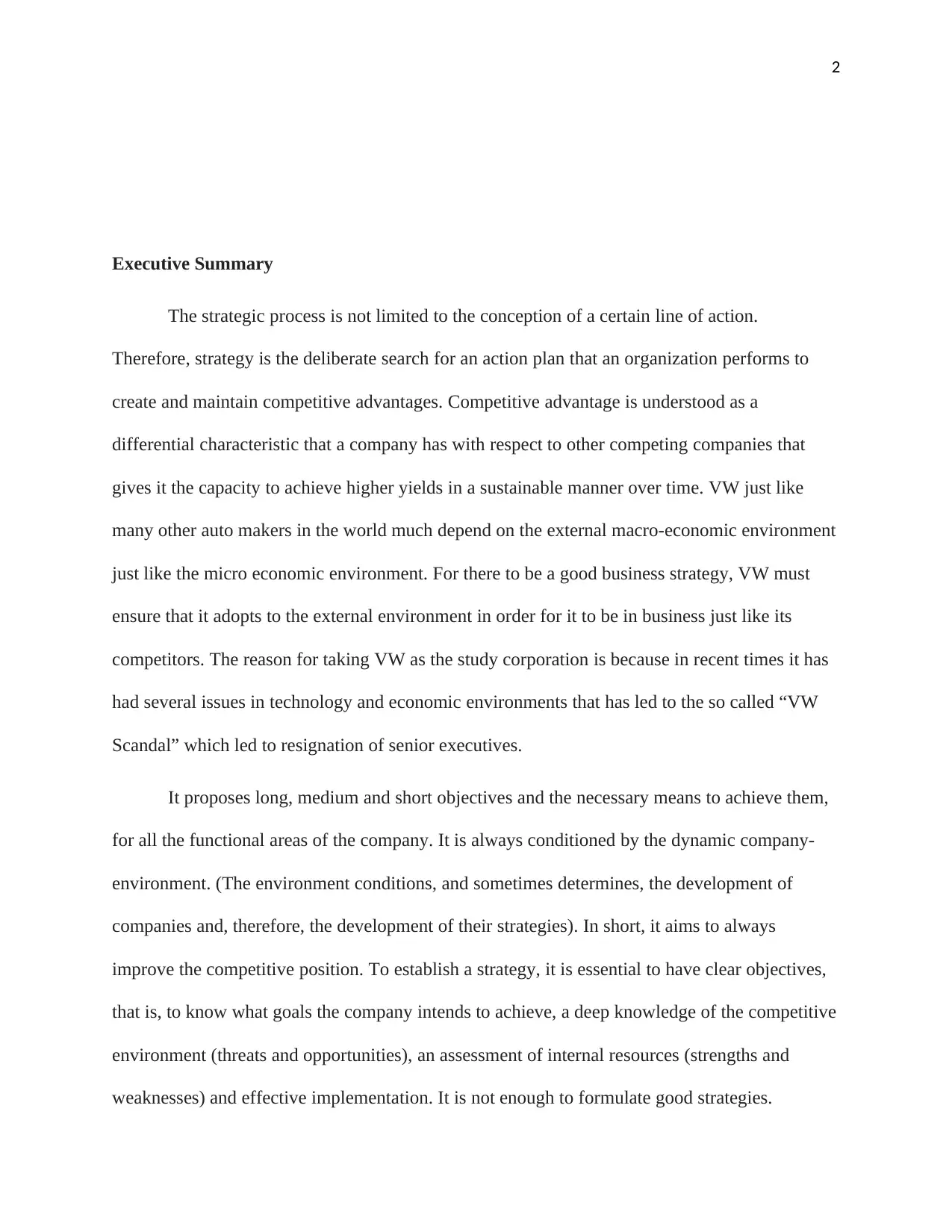
2
Executive Summary
The strategic process is not limited to the conception of a certain line of action.
Therefore, strategy is the deliberate search for an action plan that an organization performs to
create and maintain competitive advantages. Competitive advantage is understood as a
differential characteristic that a company has with respect to other competing companies that
gives it the capacity to achieve higher yields in a sustainable manner over time. VW just like
many other auto makers in the world much depend on the external macro-economic environment
just like the micro economic environment. For there to be a good business strategy, VW must
ensure that it adopts to the external environment in order for it to be in business just like its
competitors. The reason for taking VW as the study corporation is because in recent times it has
had several issues in technology and economic environments that has led to the so called “VW
Scandal” which led to resignation of senior executives.
It proposes long, medium and short objectives and the necessary means to achieve them,
for all the functional areas of the company. It is always conditioned by the dynamic company-
environment. (The environment conditions, and sometimes determines, the development of
companies and, therefore, the development of their strategies). In short, it aims to always
improve the competitive position. To establish a strategy, it is essential to have clear objectives,
that is, to know what goals the company intends to achieve, a deep knowledge of the competitive
environment (threats and opportunities), an assessment of internal resources (strengths and
weaknesses) and effective implementation. It is not enough to formulate good strategies.
Executive Summary
The strategic process is not limited to the conception of a certain line of action.
Therefore, strategy is the deliberate search for an action plan that an organization performs to
create and maintain competitive advantages. Competitive advantage is understood as a
differential characteristic that a company has with respect to other competing companies that
gives it the capacity to achieve higher yields in a sustainable manner over time. VW just like
many other auto makers in the world much depend on the external macro-economic environment
just like the micro economic environment. For there to be a good business strategy, VW must
ensure that it adopts to the external environment in order for it to be in business just like its
competitors. The reason for taking VW as the study corporation is because in recent times it has
had several issues in technology and economic environments that has led to the so called “VW
Scandal” which led to resignation of senior executives.
It proposes long, medium and short objectives and the necessary means to achieve them,
for all the functional areas of the company. It is always conditioned by the dynamic company-
environment. (The environment conditions, and sometimes determines, the development of
companies and, therefore, the development of their strategies). In short, it aims to always
improve the competitive position. To establish a strategy, it is essential to have clear objectives,
that is, to know what goals the company intends to achieve, a deep knowledge of the competitive
environment (threats and opportunities), an assessment of internal resources (strengths and
weaknesses) and effective implementation. It is not enough to formulate good strategies.
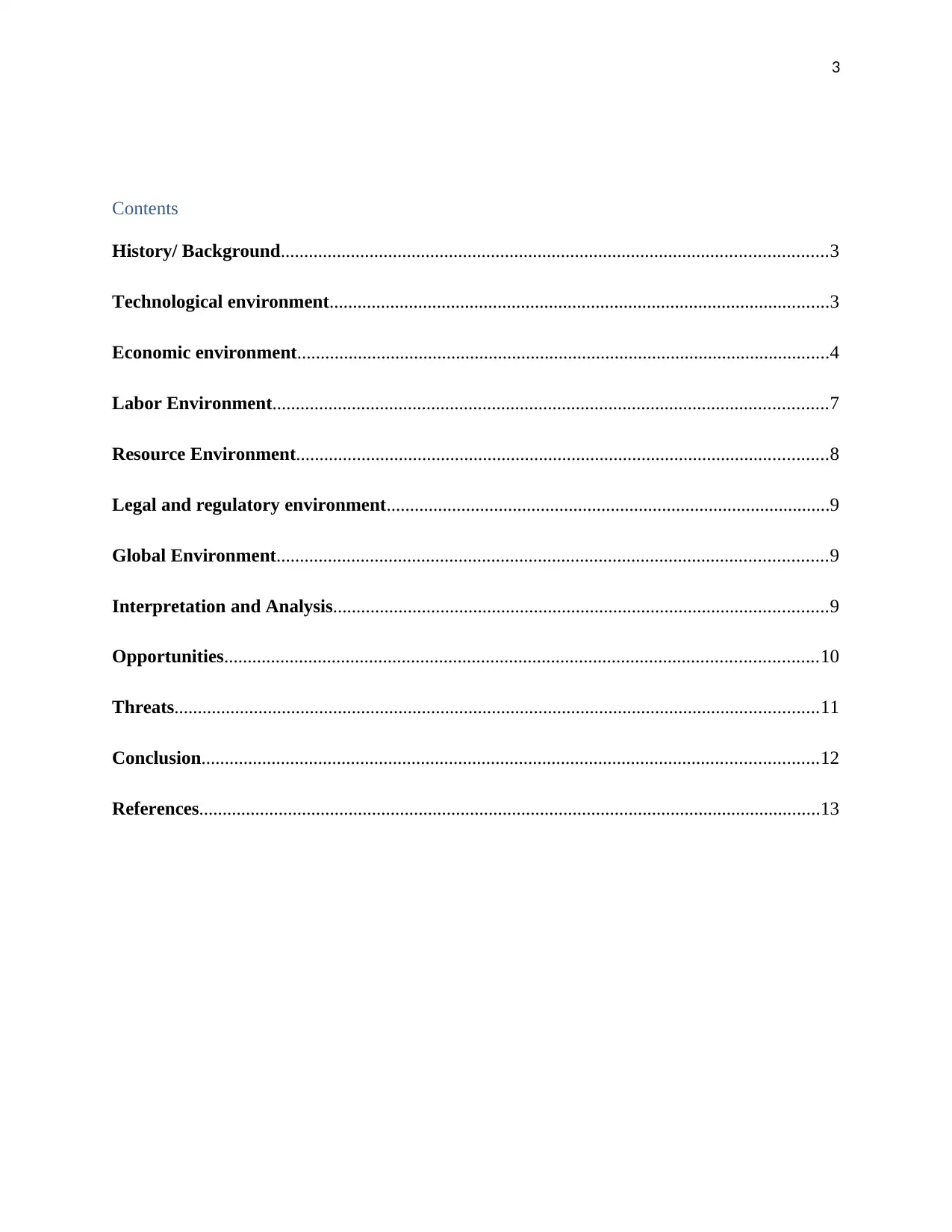
3
Contents
History/ Background.....................................................................................................................3
Technological environment...........................................................................................................3
Economic environment..................................................................................................................4
Labor Environment.......................................................................................................................7
Resource Environment..................................................................................................................8
Legal and regulatory environment...............................................................................................9
Global Environment......................................................................................................................9
Interpretation and Analysis..........................................................................................................9
Opportunities...............................................................................................................................10
Threats..........................................................................................................................................11
Conclusion....................................................................................................................................12
References.....................................................................................................................................13
Contents
History/ Background.....................................................................................................................3
Technological environment...........................................................................................................3
Economic environment..................................................................................................................4
Labor Environment.......................................................................................................................7
Resource Environment..................................................................................................................8
Legal and regulatory environment...............................................................................................9
Global Environment......................................................................................................................9
Interpretation and Analysis..........................................................................................................9
Opportunities...............................................................................................................................10
Threats..........................................................................................................................................11
Conclusion....................................................................................................................................12
References.....................................................................................................................................13
⊘ This is a preview!⊘
Do you want full access?
Subscribe today to unlock all pages.

Trusted by 1+ million students worldwide
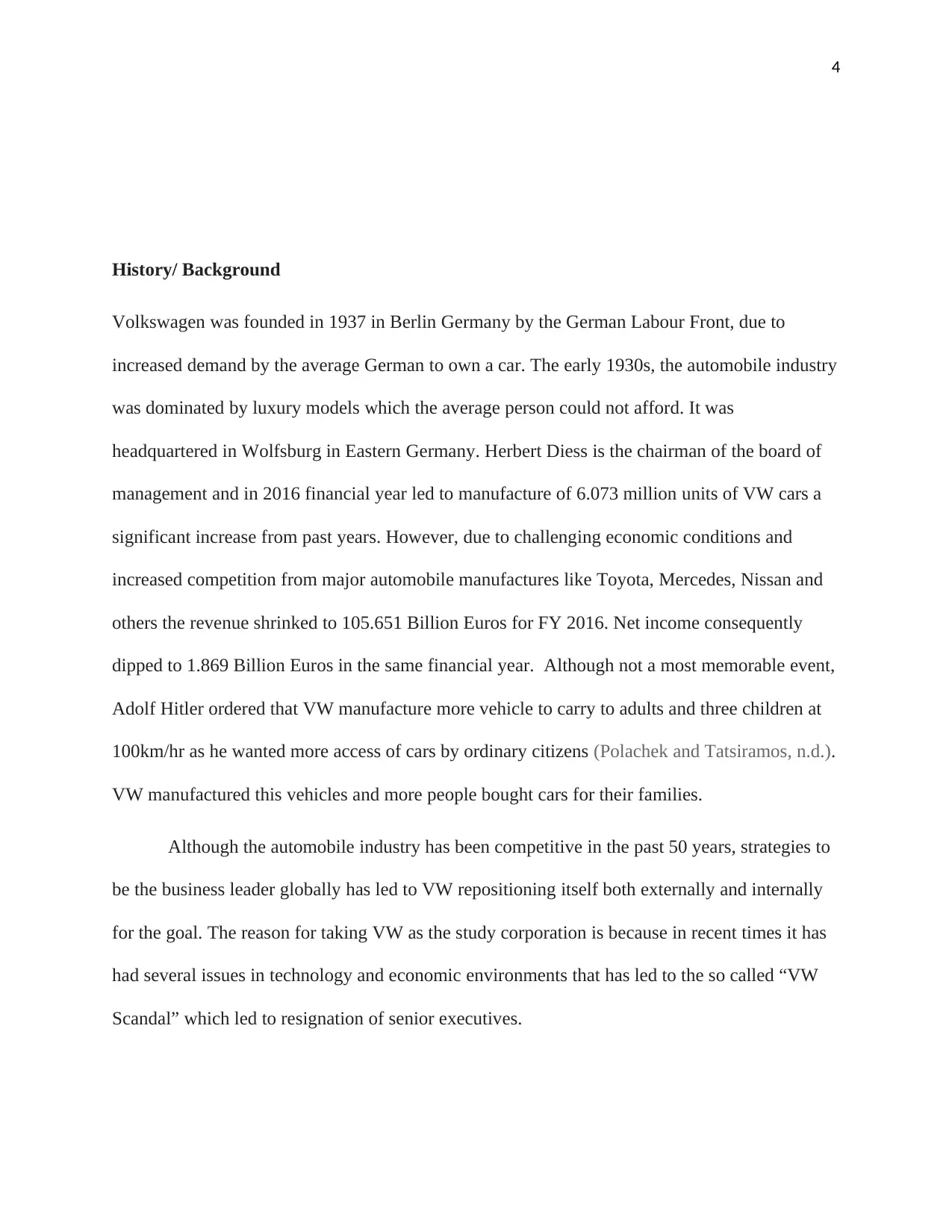
4
History/ Background
Volkswagen was founded in 1937 in Berlin Germany by the German Labour Front, due to
increased demand by the average German to own a car. The early 1930s, the automobile industry
was dominated by luxury models which the average person could not afford. It was
headquartered in Wolfsburg in Eastern Germany. Herbert Diess is the chairman of the board of
management and in 2016 financial year led to manufacture of 6.073 million units of VW cars a
significant increase from past years. However, due to challenging economic conditions and
increased competition from major automobile manufactures like Toyota, Mercedes, Nissan and
others the revenue shrinked to 105.651 Billion Euros for FY 2016. Net income consequently
dipped to 1.869 Billion Euros in the same financial year. Although not a most memorable event,
Adolf Hitler ordered that VW manufacture more vehicle to carry to adults and three children at
100km/hr as he wanted more access of cars by ordinary citizens (Polachek and Tatsiramos, n.d.).
VW manufactured this vehicles and more people bought cars for their families.
Although the automobile industry has been competitive in the past 50 years, strategies to
be the business leader globally has led to VW repositioning itself both externally and internally
for the goal. The reason for taking VW as the study corporation is because in recent times it has
had several issues in technology and economic environments that has led to the so called “VW
Scandal” which led to resignation of senior executives.
History/ Background
Volkswagen was founded in 1937 in Berlin Germany by the German Labour Front, due to
increased demand by the average German to own a car. The early 1930s, the automobile industry
was dominated by luxury models which the average person could not afford. It was
headquartered in Wolfsburg in Eastern Germany. Herbert Diess is the chairman of the board of
management and in 2016 financial year led to manufacture of 6.073 million units of VW cars a
significant increase from past years. However, due to challenging economic conditions and
increased competition from major automobile manufactures like Toyota, Mercedes, Nissan and
others the revenue shrinked to 105.651 Billion Euros for FY 2016. Net income consequently
dipped to 1.869 Billion Euros in the same financial year. Although not a most memorable event,
Adolf Hitler ordered that VW manufacture more vehicle to carry to adults and three children at
100km/hr as he wanted more access of cars by ordinary citizens (Polachek and Tatsiramos, n.d.).
VW manufactured this vehicles and more people bought cars for their families.
Although the automobile industry has been competitive in the past 50 years, strategies to
be the business leader globally has led to VW repositioning itself both externally and internally
for the goal. The reason for taking VW as the study corporation is because in recent times it has
had several issues in technology and economic environments that has led to the so called “VW
Scandal” which led to resignation of senior executives.
Paraphrase This Document
Need a fresh take? Get an instant paraphrase of this document with our AI Paraphraser
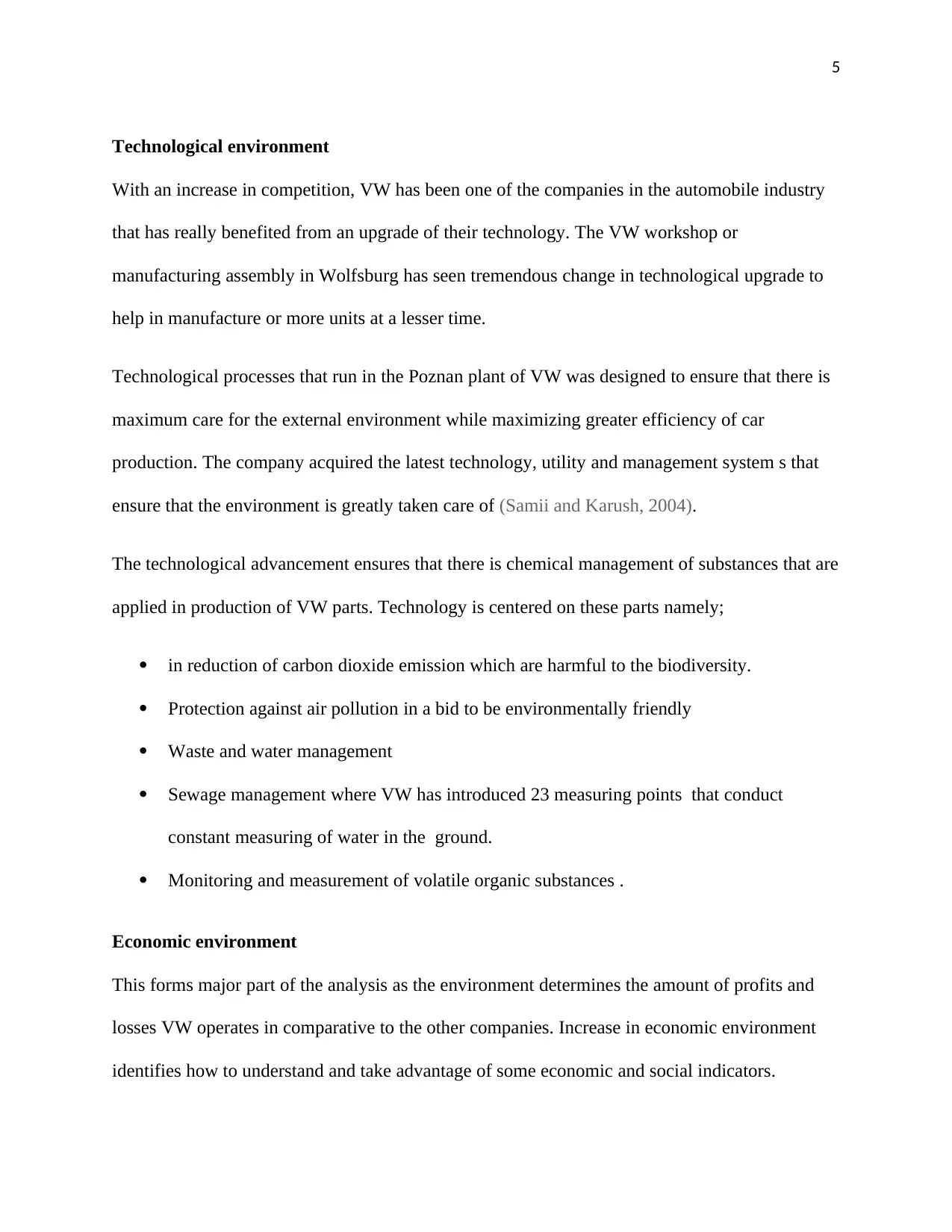
5
Technological environment
With an increase in competition, VW has been one of the companies in the automobile industry
that has really benefited from an upgrade of their technology. The VW workshop or
manufacturing assembly in Wolfsburg has seen tremendous change in technological upgrade to
help in manufacture or more units at a lesser time.
Technological processes that run in the Poznan plant of VW was designed to ensure that there is
maximum care for the external environment while maximizing greater efficiency of car
production. The company acquired the latest technology, utility and management system s that
ensure that the environment is greatly taken care of (Samii and Karush, 2004).
The technological advancement ensures that there is chemical management of substances that are
applied in production of VW parts. Technology is centered on these parts namely;
in reduction of carbon dioxide emission which are harmful to the biodiversity.
Protection against air pollution in a bid to be environmentally friendly
Waste and water management
Sewage management where VW has introduced 23 measuring points that conduct
constant measuring of water in the ground.
Monitoring and measurement of volatile organic substances .
Economic environment
This forms major part of the analysis as the environment determines the amount of profits and
losses VW operates in comparative to the other companies. Increase in economic environment
identifies how to understand and take advantage of some economic and social indicators.
Technological environment
With an increase in competition, VW has been one of the companies in the automobile industry
that has really benefited from an upgrade of their technology. The VW workshop or
manufacturing assembly in Wolfsburg has seen tremendous change in technological upgrade to
help in manufacture or more units at a lesser time.
Technological processes that run in the Poznan plant of VW was designed to ensure that there is
maximum care for the external environment while maximizing greater efficiency of car
production. The company acquired the latest technology, utility and management system s that
ensure that the environment is greatly taken care of (Samii and Karush, 2004).
The technological advancement ensures that there is chemical management of substances that are
applied in production of VW parts. Technology is centered on these parts namely;
in reduction of carbon dioxide emission which are harmful to the biodiversity.
Protection against air pollution in a bid to be environmentally friendly
Waste and water management
Sewage management where VW has introduced 23 measuring points that conduct
constant measuring of water in the ground.
Monitoring and measurement of volatile organic substances .
Economic environment
This forms major part of the analysis as the environment determines the amount of profits and
losses VW operates in comparative to the other companies. Increase in economic environment
identifies how to understand and take advantage of some economic and social indicators.
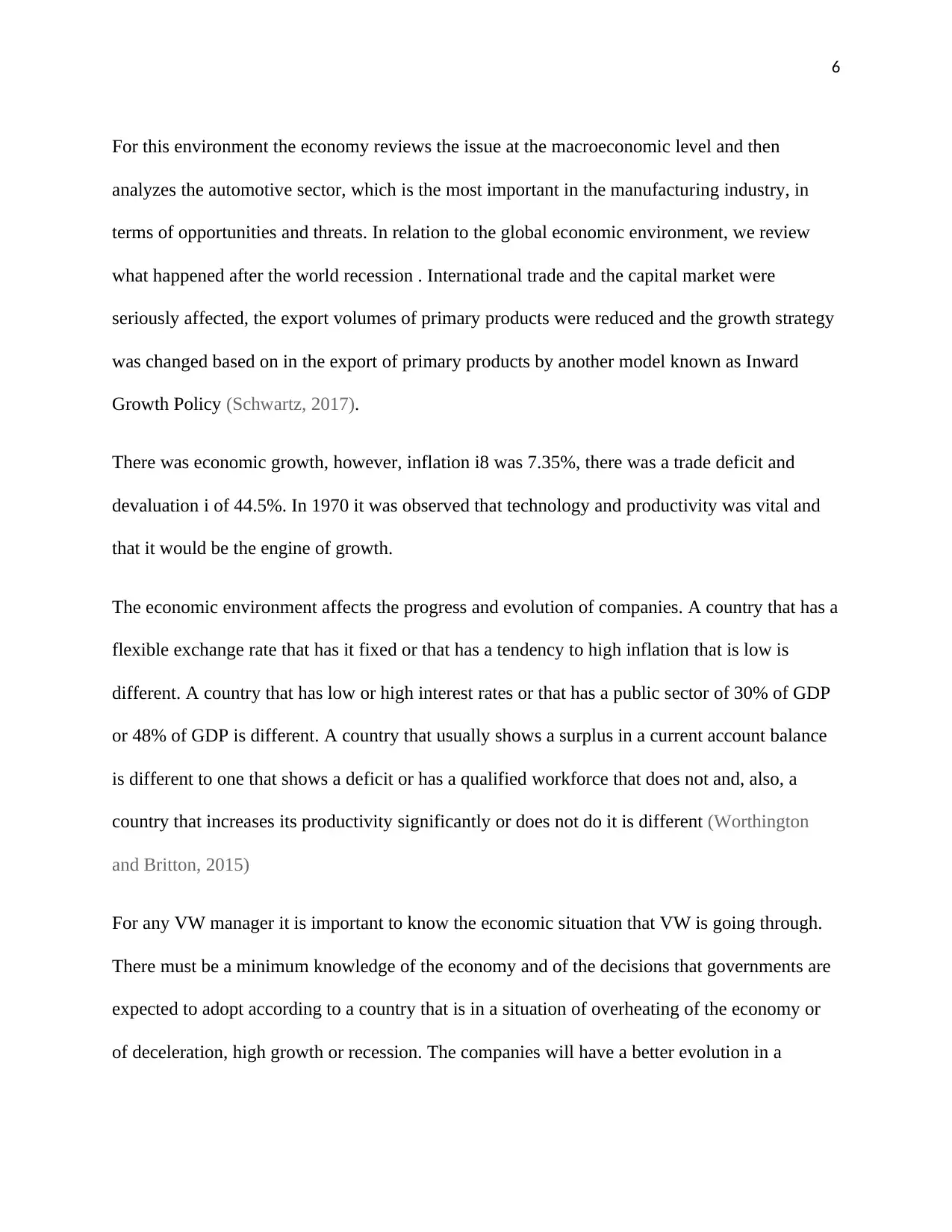
6
For this environment the economy reviews the issue at the macroeconomic level and then
analyzes the automotive sector, which is the most important in the manufacturing industry, in
terms of opportunities and threats. In relation to the global economic environment, we review
what happened after the world recession . International trade and the capital market were
seriously affected, the export volumes of primary products were reduced and the growth strategy
was changed based on in the export of primary products by another model known as Inward
Growth Policy (Schwartz, 2017).
There was economic growth, however, inflation i8 was 7.35%, there was a trade deficit and
devaluation i of 44.5%. In 1970 it was observed that technology and productivity was vital and
that it would be the engine of growth.
The economic environment affects the progress and evolution of companies. A country that has a
flexible exchange rate that has it fixed or that has a tendency to high inflation that is low is
different. A country that has low or high interest rates or that has a public sector of 30% of GDP
or 48% of GDP is different. A country that usually shows a surplus in a current account balance
is different to one that shows a deficit or has a qualified workforce that does not and, also, a
country that increases its productivity significantly or does not do it is different (Worthington
and Britton, 2015)
For any VW manager it is important to know the economic situation that VW is going through.
There must be a minimum knowledge of the economy and of the decisions that governments are
expected to adopt according to a country that is in a situation of overheating of the economy or
of deceleration, high growth or recession. The companies will have a better evolution in a
For this environment the economy reviews the issue at the macroeconomic level and then
analyzes the automotive sector, which is the most important in the manufacturing industry, in
terms of opportunities and threats. In relation to the global economic environment, we review
what happened after the world recession . International trade and the capital market were
seriously affected, the export volumes of primary products were reduced and the growth strategy
was changed based on in the export of primary products by another model known as Inward
Growth Policy (Schwartz, 2017).
There was economic growth, however, inflation i8 was 7.35%, there was a trade deficit and
devaluation i of 44.5%. In 1970 it was observed that technology and productivity was vital and
that it would be the engine of growth.
The economic environment affects the progress and evolution of companies. A country that has a
flexible exchange rate that has it fixed or that has a tendency to high inflation that is low is
different. A country that has low or high interest rates or that has a public sector of 30% of GDP
or 48% of GDP is different. A country that usually shows a surplus in a current account balance
is different to one that shows a deficit or has a qualified workforce that does not and, also, a
country that increases its productivity significantly or does not do it is different (Worthington
and Britton, 2015)
For any VW manager it is important to know the economic situation that VW is going through.
There must be a minimum knowledge of the economy and of the decisions that governments are
expected to adopt according to a country that is in a situation of overheating of the economy or
of deceleration, high growth or recession. The companies will have a better evolution in a
⊘ This is a preview!⊘
Do you want full access?
Subscribe today to unlock all pages.

Trusted by 1+ million students worldwide
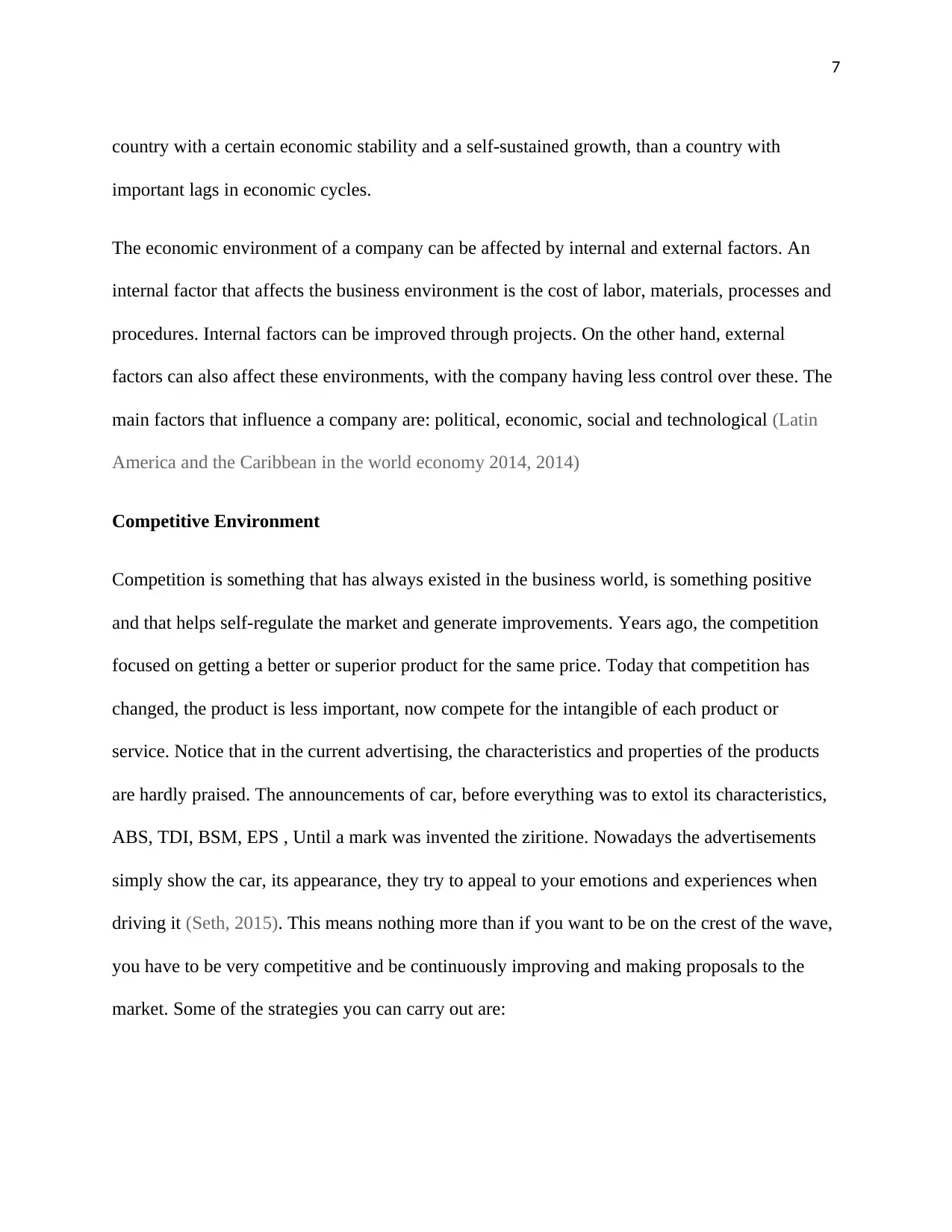
7
country with a certain economic stability and a self-sustained growth, than a country with
important lags in economic cycles.
The economic environment of a company can be affected by internal and external factors. An
internal factor that affects the business environment is the cost of labor, materials, processes and
procedures. Internal factors can be improved through projects. On the other hand, external
factors can also affect these environments, with the company having less control over these. The
main factors that influence a company are: political, economic, social and technological (Latin
America and the Caribbean in the world economy 2014, 2014)
Competitive Environment
Competition is something that has always existed in the business world, is something positive
and that helps self-regulate the market and generate improvements. Years ago, the competition
focused on getting a better or superior product for the same price. Today that competition has
changed, the product is less important, now compete for the intangible of each product or
service. Notice that in the current advertising, the characteristics and properties of the products
are hardly praised. The announcements of car, before everything was to extol its characteristics,
ABS, TDI, BSM, EPS , Until a mark was invented the ziritione. Nowadays the advertisements
simply show the car, its appearance, they try to appeal to your emotions and experiences when
driving it (Seth, 2015). This means nothing more than if you want to be on the crest of the wave,
you have to be very competitive and be continuously improving and making proposals to the
market. Some of the strategies you can carry out are:
country with a certain economic stability and a self-sustained growth, than a country with
important lags in economic cycles.
The economic environment of a company can be affected by internal and external factors. An
internal factor that affects the business environment is the cost of labor, materials, processes and
procedures. Internal factors can be improved through projects. On the other hand, external
factors can also affect these environments, with the company having less control over these. The
main factors that influence a company are: political, economic, social and technological (Latin
America and the Caribbean in the world economy 2014, 2014)
Competitive Environment
Competition is something that has always existed in the business world, is something positive
and that helps self-regulate the market and generate improvements. Years ago, the competition
focused on getting a better or superior product for the same price. Today that competition has
changed, the product is less important, now compete for the intangible of each product or
service. Notice that in the current advertising, the characteristics and properties of the products
are hardly praised. The announcements of car, before everything was to extol its characteristics,
ABS, TDI, BSM, EPS , Until a mark was invented the ziritione. Nowadays the advertisements
simply show the car, its appearance, they try to appeal to your emotions and experiences when
driving it (Seth, 2015). This means nothing more than if you want to be on the crest of the wave,
you have to be very competitive and be continuously improving and making proposals to the
market. Some of the strategies you can carry out are:
Paraphrase This Document
Need a fresh take? Get an instant paraphrase of this document with our AI Paraphraser
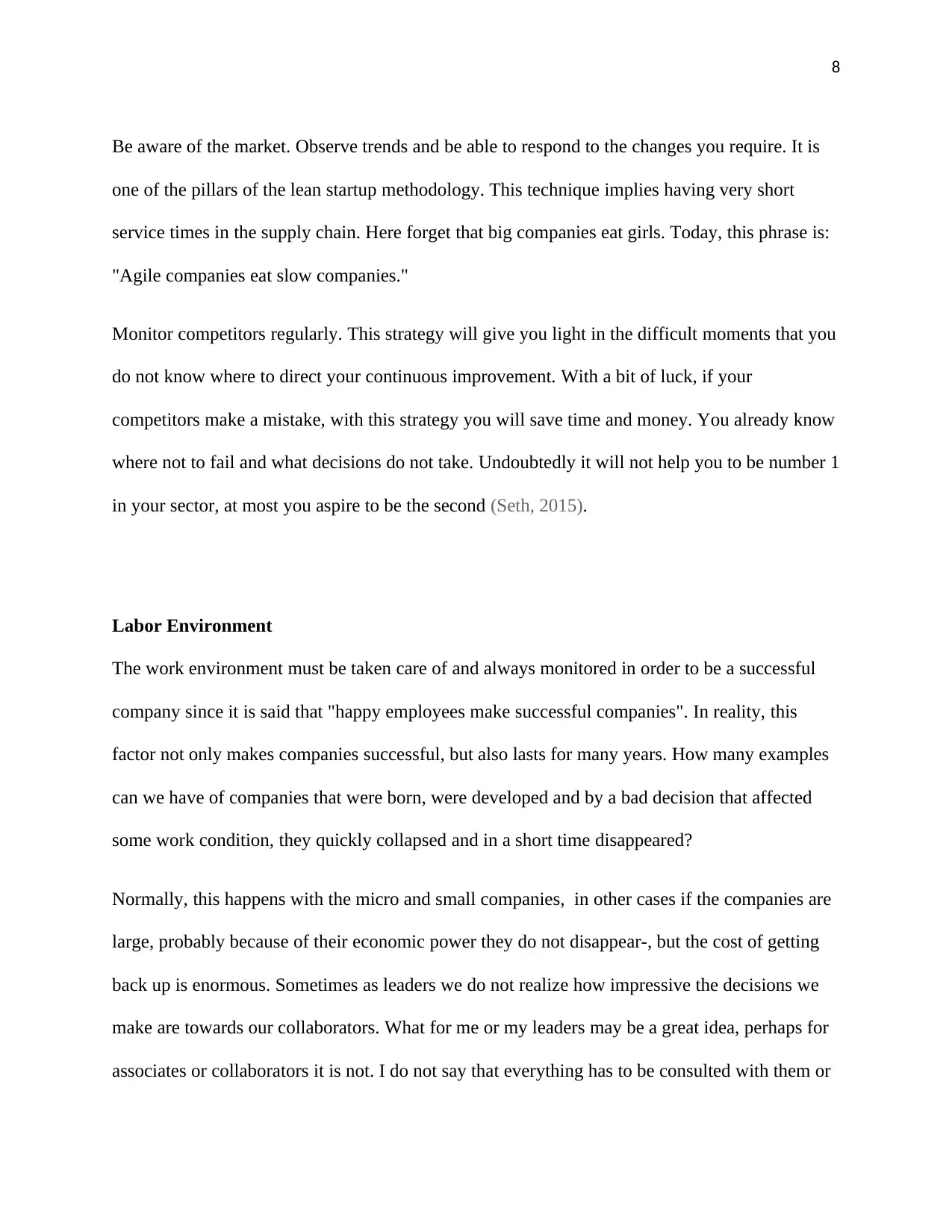
8
Be aware of the market. Observe trends and be able to respond to the changes you require. It is
one of the pillars of the lean startup methodology. This technique implies having very short
service times in the supply chain. Here forget that big companies eat girls. Today, this phrase is:
"Agile companies eat slow companies."
Monitor competitors regularly. This strategy will give you light in the difficult moments that you
do not know where to direct your continuous improvement. With a bit of luck, if your
competitors make a mistake, with this strategy you will save time and money. You already know
where not to fail and what decisions do not take. Undoubtedly it will not help you to be number 1
in your sector, at most you aspire to be the second (Seth, 2015).
Labor Environment
The work environment must be taken care of and always monitored in order to be a successful
company since it is said that "happy employees make successful companies". In reality, this
factor not only makes companies successful, but also lasts for many years. How many examples
can we have of companies that were born, were developed and by a bad decision that affected
some work condition, they quickly collapsed and in a short time disappeared?
Normally, this happens with the micro and small companies, in other cases if the companies are
large, probably because of their economic power they do not disappear-, but the cost of getting
back up is enormous. Sometimes as leaders we do not realize how impressive the decisions we
make are towards our collaborators. What for me or my leaders may be a great idea, perhaps for
associates or collaborators it is not. I do not say that everything has to be consulted with them or
Be aware of the market. Observe trends and be able to respond to the changes you require. It is
one of the pillars of the lean startup methodology. This technique implies having very short
service times in the supply chain. Here forget that big companies eat girls. Today, this phrase is:
"Agile companies eat slow companies."
Monitor competitors regularly. This strategy will give you light in the difficult moments that you
do not know where to direct your continuous improvement. With a bit of luck, if your
competitors make a mistake, with this strategy you will save time and money. You already know
where not to fail and what decisions do not take. Undoubtedly it will not help you to be number 1
in your sector, at most you aspire to be the second (Seth, 2015).
Labor Environment
The work environment must be taken care of and always monitored in order to be a successful
company since it is said that "happy employees make successful companies". In reality, this
factor not only makes companies successful, but also lasts for many years. How many examples
can we have of companies that were born, were developed and by a bad decision that affected
some work condition, they quickly collapsed and in a short time disappeared?
Normally, this happens with the micro and small companies, in other cases if the companies are
large, probably because of their economic power they do not disappear-, but the cost of getting
back up is enormous. Sometimes as leaders we do not realize how impressive the decisions we
make are towards our collaborators. What for me or my leaders may be a great idea, perhaps for
associates or collaborators it is not. I do not say that everything has to be consulted with them or
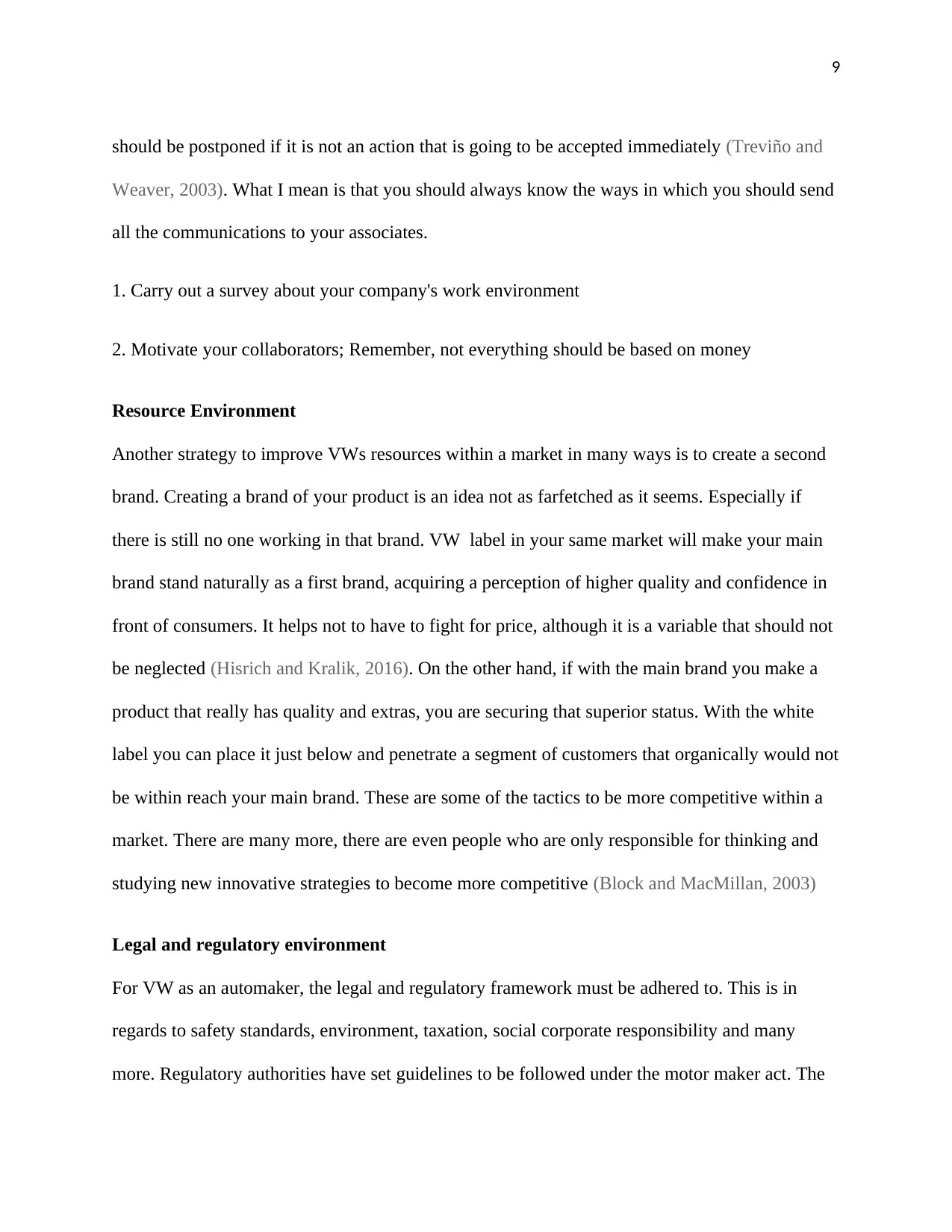
9
should be postponed if it is not an action that is going to be accepted immediately (Treviño and
Weaver, 2003). What I mean is that you should always know the ways in which you should send
all the communications to your associates.
1. Carry out a survey about your company's work environment
2. Motivate your collaborators; Remember, not everything should be based on money
Resource Environment
Another strategy to improve VWs resources within a market in many ways is to create a second
brand. Creating a brand of your product is an idea not as farfetched as it seems. Especially if
there is still no one working in that brand. VW label in your same market will make your main
brand stand naturally as a first brand, acquiring a perception of higher quality and confidence in
front of consumers. It helps not to have to fight for price, although it is a variable that should not
be neglected (Hisrich and Kralik, 2016). On the other hand, if with the main brand you make a
product that really has quality and extras, you are securing that superior status. With the white
label you can place it just below and penetrate a segment of customers that organically would not
be within reach your main brand. These are some of the tactics to be more competitive within a
market. There are many more, there are even people who are only responsible for thinking and
studying new innovative strategies to become more competitive (Block and MacMillan, 2003)
Legal and regulatory environment
For VW as an automaker, the legal and regulatory framework must be adhered to. This is in
regards to safety standards, environment, taxation, social corporate responsibility and many
more. Regulatory authorities have set guidelines to be followed under the motor maker act. The
should be postponed if it is not an action that is going to be accepted immediately (Treviño and
Weaver, 2003). What I mean is that you should always know the ways in which you should send
all the communications to your associates.
1. Carry out a survey about your company's work environment
2. Motivate your collaborators; Remember, not everything should be based on money
Resource Environment
Another strategy to improve VWs resources within a market in many ways is to create a second
brand. Creating a brand of your product is an idea not as farfetched as it seems. Especially if
there is still no one working in that brand. VW label in your same market will make your main
brand stand naturally as a first brand, acquiring a perception of higher quality and confidence in
front of consumers. It helps not to have to fight for price, although it is a variable that should not
be neglected (Hisrich and Kralik, 2016). On the other hand, if with the main brand you make a
product that really has quality and extras, you are securing that superior status. With the white
label you can place it just below and penetrate a segment of customers that organically would not
be within reach your main brand. These are some of the tactics to be more competitive within a
market. There are many more, there are even people who are only responsible for thinking and
studying new innovative strategies to become more competitive (Block and MacMillan, 2003)
Legal and regulatory environment
For VW as an automaker, the legal and regulatory framework must be adhered to. This is in
regards to safety standards, environment, taxation, social corporate responsibility and many
more. Regulatory authorities have set guidelines to be followed under the motor maker act. The
⊘ This is a preview!⊘
Do you want full access?
Subscribe today to unlock all pages.

Trusted by 1+ million students worldwide
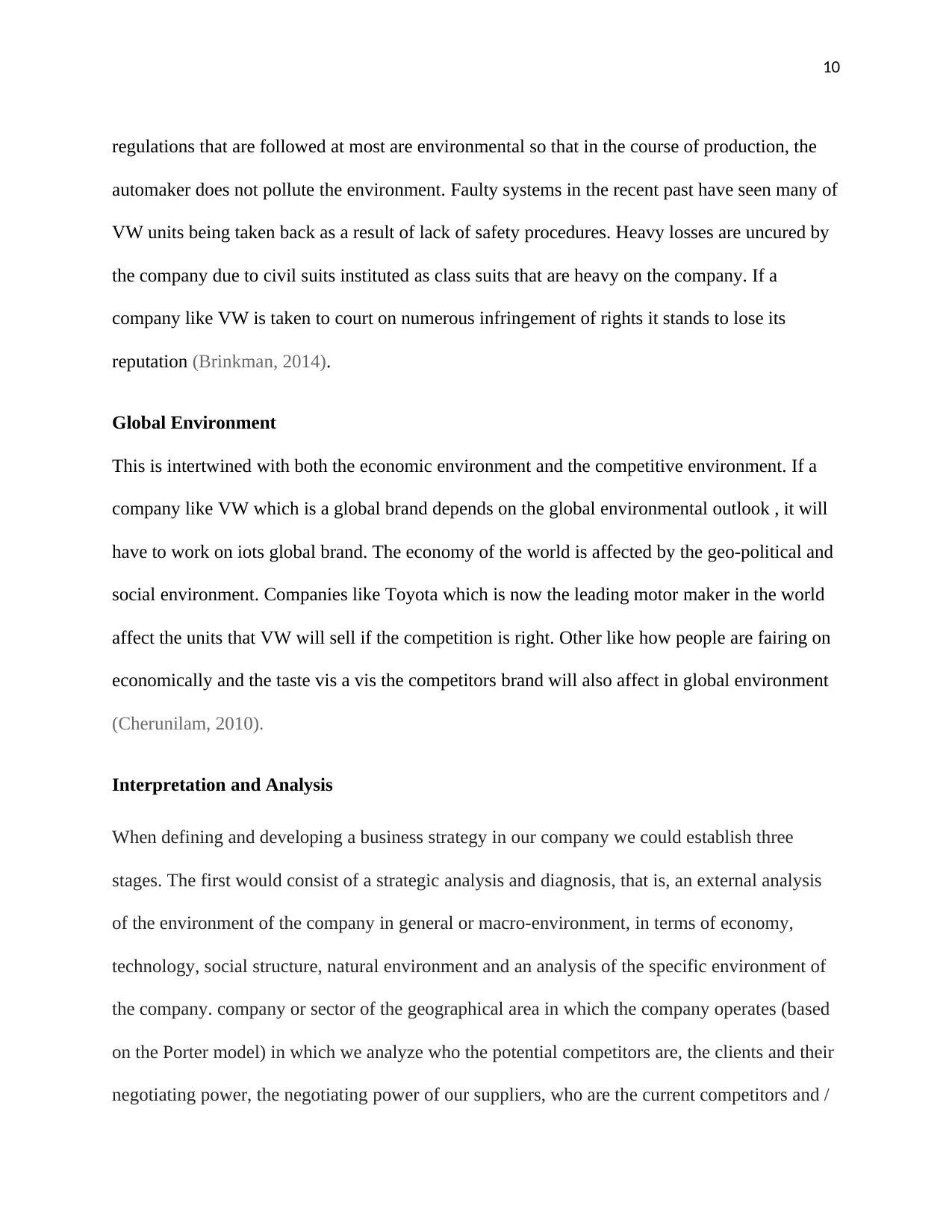
10
regulations that are followed at most are environmental so that in the course of production, the
automaker does not pollute the environment. Faulty systems in the recent past have seen many of
VW units being taken back as a result of lack of safety procedures. Heavy losses are uncured by
the company due to civil suits instituted as class suits that are heavy on the company. If a
company like VW is taken to court on numerous infringement of rights it stands to lose its
reputation (Brinkman, 2014).
Global Environment
This is intertwined with both the economic environment and the competitive environment. If a
company like VW which is a global brand depends on the global environmental outlook , it will
have to work on iots global brand. The economy of the world is affected by the geo-political and
social environment. Companies like Toyota which is now the leading motor maker in the world
affect the units that VW will sell if the competition is right. Other like how people are fairing on
economically and the taste vis a vis the competitors brand will also affect in global environment
(Cherunilam, 2010).
Interpretation and Analysis
When defining and developing a business strategy in our company we could establish three
stages. The first would consist of a strategic analysis and diagnosis, that is, an external analysis
of the environment of the company in general or macro-environment, in terms of economy,
technology, social structure, natural environment and an analysis of the specific environment of
the company. company or sector of the geographical area in which the company operates (based
on the Porter model) in which we analyze who the potential competitors are, the clients and their
negotiating power, the negotiating power of our suppliers, who are the current competitors and /
regulations that are followed at most are environmental so that in the course of production, the
automaker does not pollute the environment. Faulty systems in the recent past have seen many of
VW units being taken back as a result of lack of safety procedures. Heavy losses are uncured by
the company due to civil suits instituted as class suits that are heavy on the company. If a
company like VW is taken to court on numerous infringement of rights it stands to lose its
reputation (Brinkman, 2014).
Global Environment
This is intertwined with both the economic environment and the competitive environment. If a
company like VW which is a global brand depends on the global environmental outlook , it will
have to work on iots global brand. The economy of the world is affected by the geo-political and
social environment. Companies like Toyota which is now the leading motor maker in the world
affect the units that VW will sell if the competition is right. Other like how people are fairing on
economically and the taste vis a vis the competitors brand will also affect in global environment
(Cherunilam, 2010).
Interpretation and Analysis
When defining and developing a business strategy in our company we could establish three
stages. The first would consist of a strategic analysis and diagnosis, that is, an external analysis
of the environment of the company in general or macro-environment, in terms of economy,
technology, social structure, natural environment and an analysis of the specific environment of
the company. company or sector of the geographical area in which the company operates (based
on the Porter model) in which we analyze who the potential competitors are, the clients and their
negotiating power, the negotiating power of our suppliers, who are the current competitors and /
Paraphrase This Document
Need a fresh take? Get an instant paraphrase of this document with our AI Paraphraser
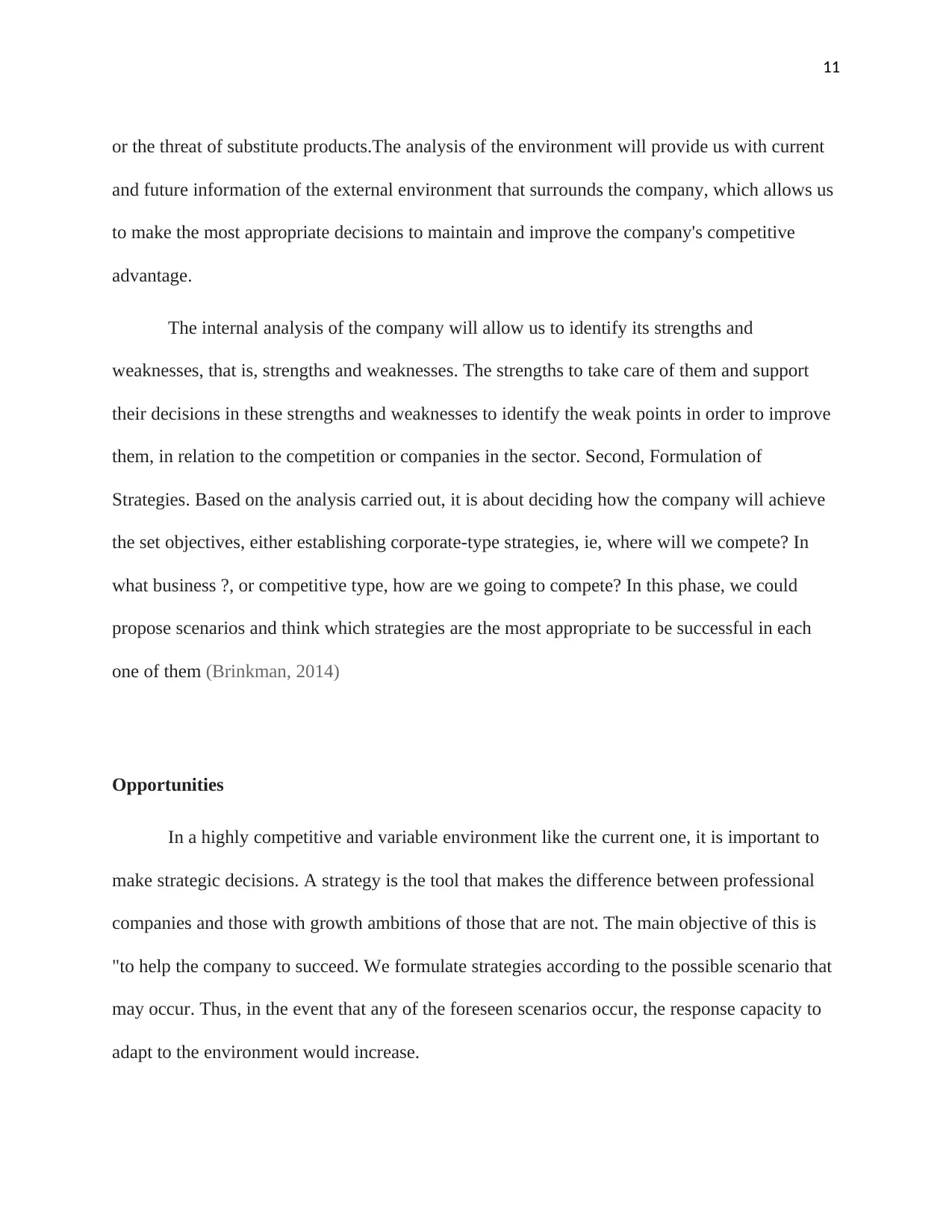
11
or the threat of substitute products.The analysis of the environment will provide us with current
and future information of the external environment that surrounds the company, which allows us
to make the most appropriate decisions to maintain and improve the company's competitive
advantage.
The internal analysis of the company will allow us to identify its strengths and
weaknesses, that is, strengths and weaknesses. The strengths to take care of them and support
their decisions in these strengths and weaknesses to identify the weak points in order to improve
them, in relation to the competition or companies in the sector. Second, Formulation of
Strategies. Based on the analysis carried out, it is about deciding how the company will achieve
the set objectives, either establishing corporate-type strategies, ie, where will we compete? In
what business ?, or competitive type, how are we going to compete? In this phase, we could
propose scenarios and think which strategies are the most appropriate to be successful in each
one of them (Brinkman, 2014)
Opportunities
In a highly competitive and variable environment like the current one, it is important to
make strategic decisions. A strategy is the tool that makes the difference between professional
companies and those with growth ambitions of those that are not. The main objective of this is
"to help the company to succeed. We formulate strategies according to the possible scenario that
may occur. Thus, in the event that any of the foreseen scenarios occur, the response capacity to
adapt to the environment would increase.
or the threat of substitute products.The analysis of the environment will provide us with current
and future information of the external environment that surrounds the company, which allows us
to make the most appropriate decisions to maintain and improve the company's competitive
advantage.
The internal analysis of the company will allow us to identify its strengths and
weaknesses, that is, strengths and weaknesses. The strengths to take care of them and support
their decisions in these strengths and weaknesses to identify the weak points in order to improve
them, in relation to the competition or companies in the sector. Second, Formulation of
Strategies. Based on the analysis carried out, it is about deciding how the company will achieve
the set objectives, either establishing corporate-type strategies, ie, where will we compete? In
what business ?, or competitive type, how are we going to compete? In this phase, we could
propose scenarios and think which strategies are the most appropriate to be successful in each
one of them (Brinkman, 2014)
Opportunities
In a highly competitive and variable environment like the current one, it is important to
make strategic decisions. A strategy is the tool that makes the difference between professional
companies and those with growth ambitions of those that are not. The main objective of this is
"to help the company to succeed. We formulate strategies according to the possible scenario that
may occur. Thus, in the event that any of the foreseen scenarios occur, the response capacity to
adapt to the environment would increase.
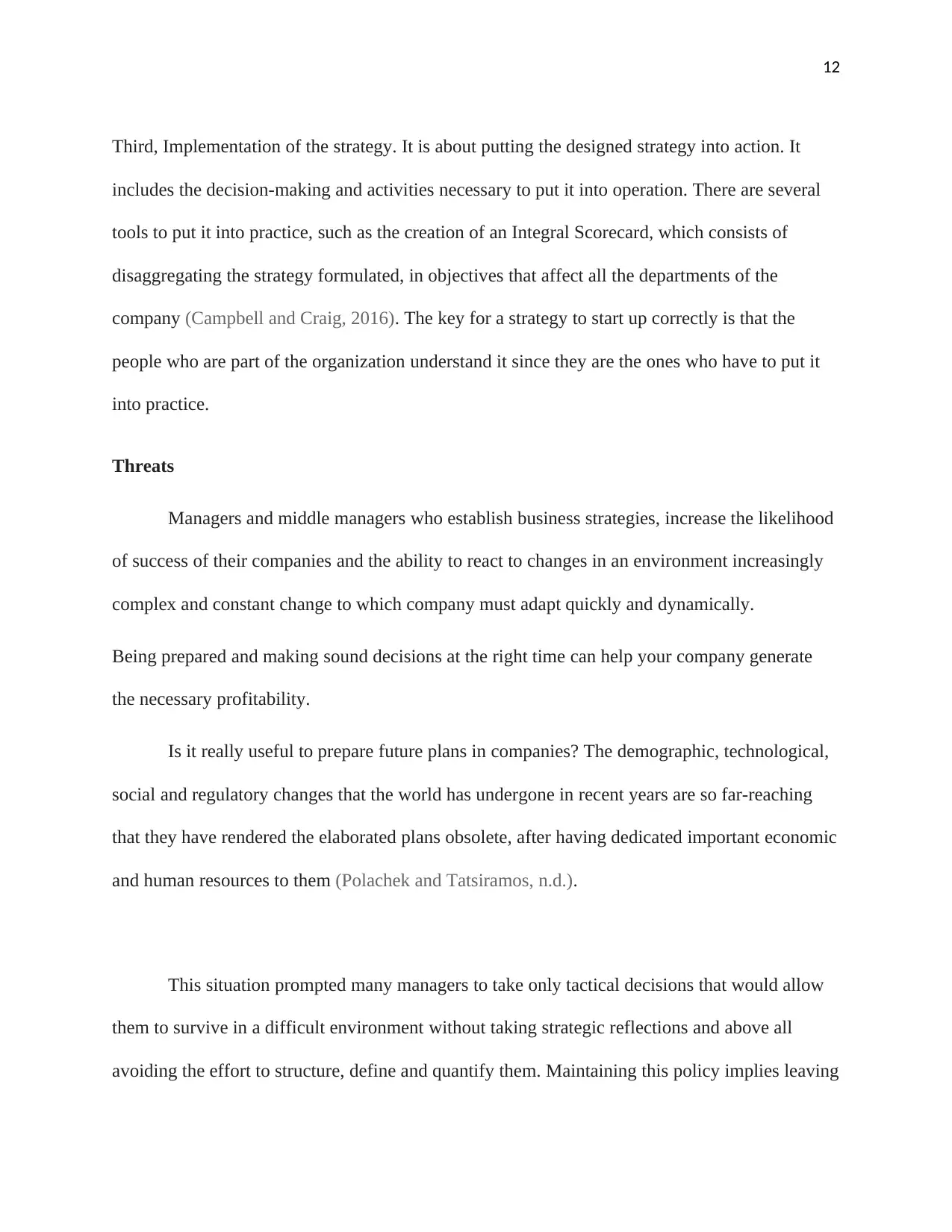
12
Third, Implementation of the strategy. It is about putting the designed strategy into action. It
includes the decision-making and activities necessary to put it into operation. There are several
tools to put it into practice, such as the creation of an Integral Scorecard, which consists of
disaggregating the strategy formulated, in objectives that affect all the departments of the
company (Campbell and Craig, 2016). The key for a strategy to start up correctly is that the
people who are part of the organization understand it since they are the ones who have to put it
into practice.
Threats
Managers and middle managers who establish business strategies, increase the likelihood
of success of their companies and the ability to react to changes in an environment increasingly
complex and constant change to which company must adapt quickly and dynamically.
Being prepared and making sound decisions at the right time can help your company generate
the necessary profitability.
Is it really useful to prepare future plans in companies? The demographic, technological,
social and regulatory changes that the world has undergone in recent years are so far-reaching
that they have rendered the elaborated plans obsolete, after having dedicated important economic
and human resources to them (Polachek and Tatsiramos, n.d.).
This situation prompted many managers to take only tactical decisions that would allow
them to survive in a difficult environment without taking strategic reflections and above all
avoiding the effort to structure, define and quantify them. Maintaining this policy implies leaving
Third, Implementation of the strategy. It is about putting the designed strategy into action. It
includes the decision-making and activities necessary to put it into operation. There are several
tools to put it into practice, such as the creation of an Integral Scorecard, which consists of
disaggregating the strategy formulated, in objectives that affect all the departments of the
company (Campbell and Craig, 2016). The key for a strategy to start up correctly is that the
people who are part of the organization understand it since they are the ones who have to put it
into practice.
Threats
Managers and middle managers who establish business strategies, increase the likelihood
of success of their companies and the ability to react to changes in an environment increasingly
complex and constant change to which company must adapt quickly and dynamically.
Being prepared and making sound decisions at the right time can help your company generate
the necessary profitability.
Is it really useful to prepare future plans in companies? The demographic, technological,
social and regulatory changes that the world has undergone in recent years are so far-reaching
that they have rendered the elaborated plans obsolete, after having dedicated important economic
and human resources to them (Polachek and Tatsiramos, n.d.).
This situation prompted many managers to take only tactical decisions that would allow
them to survive in a difficult environment without taking strategic reflections and above all
avoiding the effort to structure, define and quantify them. Maintaining this policy implies leaving
⊘ This is a preview!⊘
Do you want full access?
Subscribe today to unlock all pages.

Trusted by 1+ million students worldwide
1 out of 16
Related Documents
Your All-in-One AI-Powered Toolkit for Academic Success.
+13062052269
info@desklib.com
Available 24*7 on WhatsApp / Email
![[object Object]](/_next/static/media/star-bottom.7253800d.svg)
Unlock your academic potential
Copyright © 2020–2025 A2Z Services. All Rights Reserved. Developed and managed by ZUCOL.





